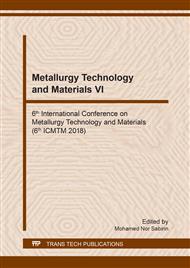[1]
M. A. Bezerra, R. E. Santelli, and L. A. Escaleira, Response surface methodology (RSM) as a tool for optimization in analytical chemistry, Talanta. 76 (2008), 965–977.
DOI: 10.1016/j.talanta.2008.05.019
Google Scholar
[2]
S. M. Njoroge, H. Koaze, and M. Sawamura, Volatile constituents of redblush grapefruit (Citrus paradisi) and pummelo (Citrus grandis) peel essential oils from Kenya, J. Agric. Food Chem. 53 (2005) 9790–9794.
DOI: 10.1021/jf051373s
Google Scholar
[3]
L. D. Latip, W. Zzaman, and T. A. Yang, Application of Response Surface Methodology to Optimize the Extraction of Asian Catfish (Clarias Batrachus) Oil Using Superheated Steam Treatment, Food Sci. Technol. 2 (2014) 69–76.
DOI: 10.13189/fst.2014.020601
Google Scholar
[4]
G. O. O. James Abiodun Adeyanju1, and O. Seyi, Optimization of oil extraction from coconut using response surface methodology, J. Chem. Pharm. Res. 8 (2016) 374–381.
Google Scholar
[5]
S. O. Egbuna, Application of rsm in optimizing the removal of ffa at the degumming stage in the refining of palm oil, Int.Jou of Scie.Res.Eng & Tec. 4 (2015) 1014–1024.
Google Scholar
[6]
H. S. Kusuma and M. Mahfud, Response Surface Methodology for Optimization Studies of Microwave- assisted Extraction of Sandalwood Oil, J. Mater. Environ. Sci. 7 (2016) 1958–(1971).
Google Scholar
[7]
F. Buang and D. Arbain, Optimization of ginger (Zingiber officinale) oil yield from malaysia in different hydrodistillation physical parameters via central composite design of response surface methodology (RSM), Res. J. Appl. Sci. Eng. Technol. 7 (2014).
DOI: 10.19026/rjaset.7.904
Google Scholar
[8]
M. S. Galadima, A. S. Ahmed, and I. M. Bugaje, Optimization of Steam Distillation of Essential Oil of Eucalyptus tereticornis by Response Surface Methodology, Niger. J. Basic Appl. Sci. 20 (2012) 368–372.
Google Scholar
[9]
H. S. Song, H. Ukeda, and M. Sawamura, Antioxidative activities of citrus peel essential oils and their components against linoleic acid oxidation, Food Sci. Technol. Res. 7 (2001) 50–56.
DOI: 10.3136/fstr.7.50
Google Scholar
[10]
M. S. Mokbel and T. Suganuma, Antioxidant and antimicrobial activities of the methanol extracts from pummelo (Citrus grandis Osbeck) fruit albedo tissues, Eur. Food Res. Technol. 224 (2006) 39–47.
DOI: 10.1007/s00217-006-0286-0
Google Scholar
[11]
L. Settanni et al., Inhibition of foodborne pathogen bacteria by essential oils extracted from citrus fruits cultivated in Sicily, Food Control. 26 (2012) 326–330.
DOI: 10.1016/j.foodcont.2012.01.050
Google Scholar
[12]
B. Uysal, F. Sozmen, O. Aktas, and E. O. Kose, Essential oil composition and antibacterial activity of the grapefruit (Citrus Paradisi. L) peel essential oils obtained by solvent-free microwave extraction: Comparison with hydrodistillation, Int. J. Food Sci. Technol. 46 (2011).
DOI: 10.1111/j.1365-2621.2011.02640.x
Google Scholar


